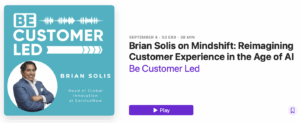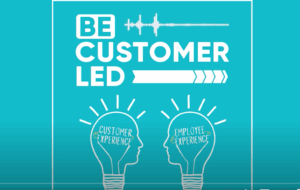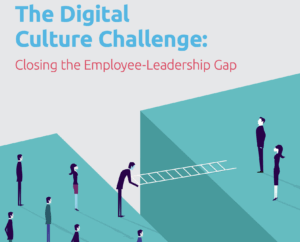While traveling Europe this year, I met Silvia Hänig who was writing a story for Haufe.de about customer experience. She followed up our initial conversation with the questions below. Instead of shooting back quick answers, I took the time, maybe too much time, to thoughtfully reply as if I were going to share the exchange with everyone. And, that’s what I’m doing here.
I hope it helps you…
Mister Solis, why is it so difficult to create Customer Experience (CX) for many people and decision makers?
Customer Experience (CX) is a difficult process, because so many stakeholders interpret CX differently and then prioritize investments and resources accordingly.
The IT department thinks it’s about technology. The marketing department focuses on channel and content trends. Customer service focuses on contact centers. Advertising creates clever campaigns and activates experiential events. And executives make decisions based on gut instinct and maybe even cognitive biases. I could go on and on. Even though these are generalizations, much of the work I’ve seen in CX isn’t really customer-focused. It’s role and process oriented.
These types of traditional perspectives hamper the vision for change. Each group inadvertently contributes to a disconnected approach to CX because they’re attempting to solve one part of the customer’s journey and experience from their silo. Yet, customers don’t see departments, they see one brand.
Just because “this is how it’s always been done” is a recipe for digital Darwinism today. CX is an opportunity to design, improve and integrate real-world experiences that the customer is going to have. In the process, businesses will have to re-align models and processes to unite disparate groups into one congruent effort. This will help companies compete in an era where customers are taking control of their experiences.
Who should own the experience? And what skills will be important in the future?
The best companies in CX take a different perspective regarding this question. They start with acknowledging that the person who owns the customer experience is…wait for it…the customer.
Think about that for a second.
They absolutely own their experience. Yet, here we are debating, who should own it. It seems that companies do everything, but understand their behaviors, expectations, preferences et al.
I define CX this way: it’s the sum of all engagements a customer has with your brand in every touchpoint, in each moment of truth, throughout the customer lifecycle. The question to ask is then, what is the experience they have? What experiences do they expect or desire? What experiences they’re receiving from other companies? More so, how are their favorite apps – for example Uber or Tinder – changing their expectations and how should you rethink the customer journey to be native, frictionless, and delightful based on outside innovation? As such, the question who owns CX, is something that should be answered in a future state and work toward that goal now.
Companies excelling here are looking at ideal customer experiences and building inside and outside for them. New cross-functional groups lead collaboration to remove friction, optimize effective touchpoints and invest innovation based on new areas of opportunity. An empathetic customer-centric approach to CX improves retention, acquisition and relationships. Great Customer Experience is all the work, that you do so your customers don’t have to…
To what extent technology should play a role in Customer Experience?
Too many businesses today take a technology-first approach to Customer Experience, which is ironically not customer centric. I call this the remote control. No one likes the remote control. We use it, because we have to. I would go so far to say that we have a reluctant relationship with it. Yet, every year, even though we get a new generation of TV innovation, we still get a remote control that looks a little different, but also gets more complex along the way. Did you know that there are on average 70 buttons on this brick and at the same time, we all have phones or tablets where we interact with them using completely different gestures? Technology is not the answer, it’s an enabler. CX should start with three “P’s” – people, purpose and promise. Technology should facilitate experiences and bring them to life.
What is the importance of CX as part of the digital transformation?
Digital transformation means something different to everyone. Just like customer experience. It is something, that is started independently in each group with different objectives. But like CX, everything is on a collision course towards convergence. Everything has to work together, otherwise you compete against yourself.
I define digital transformation this way: The re-alignment of, or new investment in, technology and business models to more effectively engage digital consumers (and employees), create new value and deliver delightful and relevant experiences at every touchpoint in the customer and employee journey.
In my research (see below), I’ve found that a common catalyst for rapid and ultimately holistic digital transformation is indeed CX. More so, by zooming in on the Digital Customer Experience (DCX) and asking what would my digital customer do and how is it affecting traditional behavior, companies can beeline towards fast innovation.
Customer Experience: Everything has to work together
This is the part where skeptics or laggards say: “Why would you focus on the digital customer? They’re a minority in the overall market. We should focus on customers as a whole!” They’re right in some aspects.
The thing is that they didn’t focus on customers. They focused on shareholders and stakeholders. Additionally, they continued to invest in technologies and systems that distanced companies from people all in the name of efficiencies, scale and profitability.
It’s the same argument with taxis in the face of Uber. They’ve had years to study how people’s experiences and expectations, how they were changing, how digital was affecting experiences and decision-making, how start-ups were placing customers at the center of services. Once Uber hit the market, it set a new standard for customer experience. People who take Uber don’t go back to taking taxis unless they have to. There’s an Uber of everything on the horizon of every business and digital transformation is the best defense and offense to compete in a digital economy.
Additional reports that will help you lead the way…
The Race Against Digital Darwinism: Six Stages of Digital Transformation
8 Success Factors of Digital Transformation: How Businesses Are Taking an Opposite Approach to Business as Usual
The 2016 State of Digital Transformation
Please read X, The Experience When Business Meets Design or visit my previous publications
Connect with Brian!
Twitter: @briansolis
Facebook: TheBrianSolis
LinkedIn: BrianSolis
Youtube: BrianSolisTV
Snapchat: BrianSolis
Invite him to speak at your next event or meeting.







Uber is the perfect example to demonstrate the necessary shift in perspective to integrate innovation in Customer Experience (CX). Mentioning that technology is only a tool to enable the shift is important too because at the center of CX really is knowing the people, purpose and promise. The technology used has to not be for show, it has to be useful and easy to integrate in the customers life, just like the remote analogy. Taxis really mixed out by not shifting to digital to fulfill current customers needs. By looking at the customers instead of company stakeholders/ investors looking just at profitability, companies can miss the opportunity to ultimately attract more customers and keep them longterm. I agree that digital can only benefit companies in the longterm and there will be an uber type app for every industry.